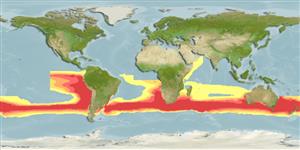>
Beloniformes (Needle fishes) >
Scomberesocidae (Sauries)
Etymology: Scomberesox: Latin, scomber = mackerel + Esox, the old name for "pike" (Ref. 45335); scombroides: From manuscript on Esox scombroides, Solander, 1772.
More on author: Richardson.
Environment: milieu / climate zone / depth range / distribution range
Écologie
marin; saumâtre; océanodrome (Ref. 51243); profondeur 0 - ? m. Subtropical
Atlantic, Indian and Pacific: generally circumglobal in temperate waters of the southern hemisphere. More common between 30°-40°S, but more northerly to 15°S near Africa and to near equator off Ecuador along South American west coast (particularly the young and juveniles). Highly migratory species.
Length at first maturity / Taille / Poids / Âge
Maturity: Lm 28.7, range 23 - 25 cm
Max length : 50.0 cm SL mâle / non sexé; (Ref. 6531)
Description synthétique
Clés d'identification | Morphologie | Morphométrie
Épines dorsales (Total) : 0; Rayons mous dorsaux (Total) : 10 - 12; Épines anales: 0; Rayons mous anaux: 12 - 14; Vertèbres: 64 - 68. Presence of toothless bill-like jaws, and finlets posterior to the dorsal and anal fins.
An epipelagic, gregarious species. Occurs in surface waters of the open sea; occasionally enters bays and inlets (Ref. 9563). Flesh is highly esteemed (Ref. 6617) but large schools are too sporadic to be of commercial importance (Ref. 6531). Feeds on small planktonic organisms, preyed upon by yellowfin tuna, Cape gunnets, marine mammals. Migrates from spawning areas to cool temperate and plankton-rich waters (Ref. 36731).
Wisner, R.L., 1990. Scomberesocidae. p. 598-603. In J.C. Quero, J.C. Hureau, C. Karrer, A. Post and L. Saldanha (eds.) Check-list of the fishes of the eastern tropical Atlantic (CLOFETA). JNICT, Lisbon; SEI, Paris; and UNESCO, Paris. Vol. 2. (Ref. 6531)
Statut dans la liste rouge de l'IUCN (Ref. 130435: Version 2024-1)
Menace pour l'homme
Harmless
Utilisations par l'homme
Pêcheries: intérêt commercial mineur; appât: usually
Outils
Articles particuliers
Télécharger en XML
Sources Internet
Estimates based on models
Preferred temperature (Ref.
123201): 14.2 - 21.3, mean 18.2 °C (based on 1430 cells).
Phylogenetic diversity index (Ref.
82804): PD
50 = 0.6562 [Uniqueness, from 0.5 = low to 2.0 = high].
Bayesian length-weight: a=0.01122 (0.00514 - 0.02450), b=3.04 (2.87 - 3.21), in cm total length, based on all LWR estimates for this body shape (Ref.
93245).
Niveau trophique (Ref.
69278): 4.1 ±0.3 se; based on diet studies.
Résilience (Ref.
120179): Milieu, temps minimum de doublement de population : 1,4 à 4,4 années (tm=3).
Fishing Vulnerability (Ref.
59153): Moderate vulnerability (44 of 100).
